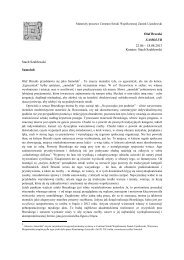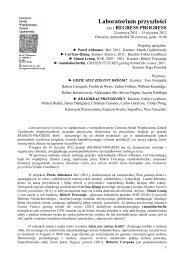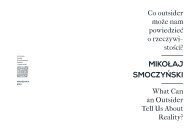KATALOG_m_zmaina alka.indd - Centrum Sztuki WspóÅczesnej - Art ...
KATALOG_m_zmaina alka.indd - Centrum Sztuki WspóÅczesnej - Art ...
KATALOG_m_zmaina alka.indd - Centrum Sztuki WspóÅczesnej - Art ...
You also want an ePaper? Increase the reach of your titles
YUMPU automatically turns print PDFs into web optimized ePapers that Google loves.
3. Games and the participation art<br />
Games and plays are only one of the participation<br />
forms used by the contemporary art.<br />
The participation is characterised by presence<br />
of the spectator, by action, co-experience<br />
and elimination of the division authorreceiver.<br />
The practice of participation was<br />
present in the Polish art of the seventies (e.g.<br />
Play with the audience of the KwieKulik duet,<br />
where the artists created the context in which<br />
the spectator was active); in the contextual<br />
(manifests of Jan Świdziński) or situationist<br />
art (urban dérive). Guy Debord, founder of<br />
the Situationist International, was one of the<br />
first to postulate rejection of the spectacle<br />
as a medium immobilising the spectator and<br />
making impossible the communication aiming<br />
at construction of the situation and activation<br />
of participants – so that not the thing<br />
they watch is interesting but they themselves<br />
become interesting and creative. Contrary<br />
to the Brechtowski’s effect of alienation, the<br />
situationists postulated creation of acts of<br />
‘experiencing’ and playing games devoid of<br />
the element of competition.<br />
In the nineties, one of the arts referring to the<br />
experiencing of the situation in the West was<br />
the relation art defined by Nicolas Bourriaud.<br />
This art was based on intersubjectivity and<br />
its main subject was being-together (l’êtreensemble)<br />
and the meeting of the painting<br />
and the spectator. The French critic looks at<br />
the work of such artists as Philippe Parreno,<br />
Rikrit Tiravanija or Carsten Höller,seeing them<br />
as responsible for offering people small services/actions/situations,<br />
referring to the basic<br />
human gestures of donation and exchange,<br />
now disappearing in the mechanised world<br />
of ATMs and automatic awakening. Parreno,<br />
invited to a gallery in Dijon, wanted to use the<br />
measure of time (2 hours) instead of space<br />
(10m 2 ) while organising an event in the gallery<br />
or organised the 1 st May action of practicing<br />
his hobby at a production line. Tiravanija, during<br />
the Venetian Biennale, organised a Thai<br />
soup cooking course or invited to a house of<br />
a famous collector for cooking Asian food.<br />
Such widely understood relation art, using<br />
the participation as an ephemeral relation between<br />
people, can however fall into a trap of<br />
superficiality. It transforms relations between<br />
people into a self-sufficient mechanism which<br />
sometimes ephemerally or even parasitically<br />
engages the spectator for the purposes of<br />
the spectacularity of situation, dangerously<br />
close to the now popular marketing phenomena<br />
such as ‘team-building’ or ‘event’. In my<br />
opinion, the participation should be characterised<br />
by a symbolic added value, such as<br />
social revitalisation or awakening of critical<br />
awareness through gesture and action; at<br />
the same time taking into consideration the<br />
expectances and context in which the spectator/participant<br />
finds itself.<br />
An example of such participation art is the<br />
Call Cutta project of the German group Rimini<br />
Protokoll realised in the Hebbel Theater in<br />
Berlin 4 . In the box office spectators obtained<br />
a mobile phone instead of a ticket. A warm<br />
voice with a strange accent in English guided<br />
them around the local district, described the<br />
history of the buildings, drew their attention<br />
to a hole in the pavement, led to unknown<br />
places. During the walk an informal relation<br />
was created between the spectator and<br />
their invisible guide; even such questions as<br />
‘Have you ever fallen in love by phone?’ were<br />
asked. When the stroller had the impression<br />
that they will meet their guide in a minute or<br />
two, they were asked to enter a TV store.<br />
One of the screens displayed the image of<br />
a Hindu call-center worker in Kalkuta, being<br />
their Berlin guide. The work in such call-center<br />
in India, servicing large European tourist,<br />
information, and communication companies<br />
is one of the best paid jobs. The spectator<br />
135









